MENU
The Electronic Scholarly Publishing Project: Providing access to classic scientific papers and other scholarly materials, since 1993. More About: ESP | OUR CONTENT | THIS WEBSITE | WHAT'S NEW | WHAT'S HOT
Comparative Timelines
The ESP Timeline (one of the site's most popular features) has been completely updated to allow the user to select (using the timeline controls above each column) different topics for the left and right sides of the display.
Select:
New Left Column
New Left Column
Dates
Decade
New Right Column
New Right Column
 Charles Lyell's multi-volume Principles of Geology appear (between 1830 amd 1833), advancing the theory of uniformitarianism, i.e., the view that geological formations are explainable in terms of forces and conditions observable at present.
Charles Lyell's multi-volume Principles of Geology appear (between 1830 amd 1833), advancing the theory of uniformitarianism, i.e., the view that geological formations are explainable in terms of forces and conditions observable at present.
1830
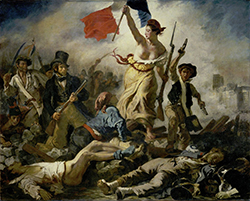 Painting by Eugène Delacroix: Liberty Leading the People (French: La Liberté guidant le peuple) commemorates the July Revolution of 1830, which toppled King Charles X of France. A woman personifying the concept and the Goddess of Liberty leads the people forward over a barricade and the bodies of the fallen, holding the flag of the French Revolution — the tricolour flag, which remains France's national flag — in one hand and brandishing a bayonetted musket with the other. The figure of Liberty is also viewed as a symbol of France and the French Republic known as Marianne. By the time Delacroix painted Liberty Leading the People, he was already the acknowledged leader of the Romantic school in French painting.
Painting by Eugène Delacroix: Liberty Leading the People (French: La Liberté guidant le peuple) commemorates the July Revolution of 1830, which toppled King Charles X of France. A woman personifying the concept and the Goddess of Liberty leads the people forward over a barricade and the bodies of the fallen, holding the flag of the French Revolution — the tricolour flag, which remains France's national flag — in one hand and brandishing a bayonetted musket with the other. The figure of Liberty is also viewed as a symbol of France and the French Republic known as Marianne. By the time Delacroix painted Liberty Leading the People, he was already the acknowledged leader of the Romantic school in French painting.
 Charles Darwin joins the crew of the HMS Beagle as the ship's naturalist. The Beagle plans a two-year voyage to map the coast of South America. This turns out to be a five-year trip.
Charles Darwin joins the crew of the HMS Beagle as the ship's naturalist. The Beagle plans a two-year voyage to map the coast of South America. This turns out to be a five-year trip.
Patrick Matthew publishes On Naval Timber and Arboriculture with an appendix describing what Charles Darwin will later name natural selection. After becoming aware of Matthew's hypothesis, Darwin will acknowledge it in a reprint of On the Origin of Species.
1831
(no entry for this year)
(no entry for this year)
1832
(no entry for this year)
 The first volume of the five-volume Recherches sur les poissons fossiles (Researches on Fossil Fishes) by Jean-Louis-Rodolphe Agassiz is published.
The first volume of the five-volume Recherches sur les poissons fossiles (Researches on Fossil Fishes) by Jean-Louis-Rodolphe Agassiz is published.
1833
(no entry for this year)
(no entry for this year)
1834
(no entry for this year)
 While serving as scientific officer on the HMS Beagle, Charles Darwin visits the Galapagos Islands. He observes that the many varieties of finches on the islands seem to have developed from a common ancestor found on the mainland of South America.
While serving as scientific officer on the HMS Beagle, Charles Darwin visits the Galapagos Islands. He observes that the many varieties of finches on the islands seem to have developed from a common ancestor found on the mainland of South America.
1835
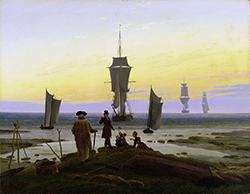 Painting by Caspar David Friedrich: The Stages of Life (German: Die Lebensstufen) is an allegorical oil painting completed just five years before his death. This picture, like many of his works, forms a meditation both on his own mortality and on the transience of life. The painting is set on a sea shore and shows in the foreground an aged man with his back turned to the viewer, walking towards two adults and two children on a hilltop overlooking a harbour. The figures are echoed by five ships shown in the harbour, each at a different distance from the shore, an allegorical reference to the different stages of human life, to the end of a journey, to the closeness of death. The figures have been identified as Friedrich and his family. The aged man is the artist himself, the small boy is his young son Gustav Adolf, the young girl is his daughter Agnes Adelheid, the older girl is his daughter Emma, and the man in the top hat is his nephew Johann Heinrich.}The Stages of Life (German: Die Lebensstufen) is an allegorical oil painting of 1835 by the German Romantic landscape painter Caspar David Friedrich. Completed just five years before his death, this picture, like many of his works, forms a meditation both on his own mortality and on the transience of life. The painting is set on a sea shore and shows in the foreground an aged man with his back turned to the viewer, walking towards two adults and two children on a hilltop overlooking a harbour. The figures are echoed by five ships shown in the harbour, each at a different distance from the shore, an allegorical reference to the different stages of human life, to the end of a journey, to the closeness of death. The figures have been identified as Friedrich and his family. The aged man is the artist himself, the small boy is his young son Gustav Adolf, the young girl is his daughter Agnes Adelheid, the older girl is his daughter Emma, and the man in the top hat is his nephew Johann Heinrich.
Painting by Caspar David Friedrich: The Stages of Life (German: Die Lebensstufen) is an allegorical oil painting completed just five years before his death. This picture, like many of his works, forms a meditation both on his own mortality and on the transience of life. The painting is set on a sea shore and shows in the foreground an aged man with his back turned to the viewer, walking towards two adults and two children on a hilltop overlooking a harbour. The figures are echoed by five ships shown in the harbour, each at a different distance from the shore, an allegorical reference to the different stages of human life, to the end of a journey, to the closeness of death. The figures have been identified as Friedrich and his family. The aged man is the artist himself, the small boy is his young son Gustav Adolf, the young girl is his daughter Agnes Adelheid, the older girl is his daughter Emma, and the man in the top hat is his nephew Johann Heinrich.}The Stages of Life (German: Die Lebensstufen) is an allegorical oil painting of 1835 by the German Romantic landscape painter Caspar David Friedrich. Completed just five years before his death, this picture, like many of his works, forms a meditation both on his own mortality and on the transience of life. The painting is set on a sea shore and shows in the foreground an aged man with his back turned to the viewer, walking towards two adults and two children on a hilltop overlooking a harbour. The figures are echoed by five ships shown in the harbour, each at a different distance from the shore, an allegorical reference to the different stages of human life, to the end of a journey, to the closeness of death. The figures have been identified as Friedrich and his family. The aged man is the artist himself, the small boy is his young son Gustav Adolf, the young girl is his daughter Agnes Adelheid, the older girl is his daughter Emma, and the man in the top hat is his nephew Johann Heinrich.
(no entry for this year)
1836
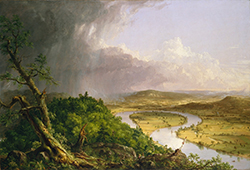 Painting by : View from Mount Holyoke, Northampton, Massachusetts, after a Thunderstorm, commonly known as The Oxbow, is a seminal landscape painting by Thomas Cole, founder of the Hudson River School. The painting depicts a Romantic panorama of the Connecticut River Valley just after a thunderstorm. It has been interpreted as a confrontation between wilderness and civilization.
Painting by : View from Mount Holyoke, Northampton, Massachusetts, after a Thunderstorm, commonly known as The Oxbow, is a seminal landscape painting by Thomas Cole, founder of the Hudson River School. The painting depicts a Romantic panorama of the Connecticut River Valley just after a thunderstorm. It has been interpreted as a confrontation between wilderness and civilization.
Charles Darwin formulates the theory of natural selection to explain evolution. Fearful of the reaction his theory will cause, he delays publishing.
1837
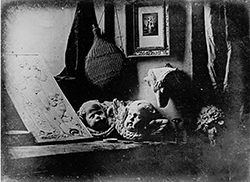 Daguerreotype by Louis Daguerre: Still life with plaster casts is the earliest, reliably dated daguerreotype.
Daguerreotype by Louis Daguerre: Still life with plaster casts is the earliest, reliably dated daguerreotype.
(no entry for this year)
1838
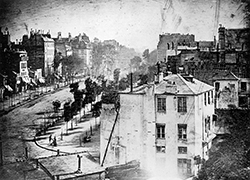 Daguerreotype by Louis Daguerre: The earliest reliably dated photograph of people, taken one spring morning in 1838 from the window of the Diorama, where Daguerre lived and worked. It bears the caption huit heure du matin (8 a.m.). Though it shows the busy Boulevard du Temple, the long exposure time (about ten or twelve minutes) meant that moving traffic cannot be seen; however, the bootblack and his customer at lower left remained still long enough to be distinctly visible. The building signage at the upper left shows that the image is laterally (left-right) reversed, as were most daguerreotypes.
Daguerreotype by Louis Daguerre: The earliest reliably dated photograph of people, taken one spring morning in 1838 from the window of the Diorama, where Daguerre lived and worked. It bears the caption huit heure du matin (8 a.m.). Though it shows the busy Boulevard du Temple, the long exposure time (about ten or twelve minutes) meant that moving traffic cannot be seen; however, the bootblack and his customer at lower left remained still long enough to be distinctly visible. The building signage at the upper left shows that the image is laterally (left-right) reversed, as were most daguerreotypes.
(no entry for this year)
1839
(no entry for this year)
ESP Quick Facts
ESP Origins
In the early 1990's, Robert Robbins was a faculty member at Johns Hopkins, where he directed the informatics core of GDB — the human gene-mapping database of the international human genome project. To share papers with colleagues around the world, he set up a small paper-sharing section on his personal web page. This small project evolved into The Electronic Scholarly Publishing Project.
ESP Support
In 1995, Robbins became the VP/IT of the Fred Hutchinson Cancer Research Center in Seattle, WA. Soon after arriving in Seattle, Robbins secured funding, through the ELSI component of the US Human Genome Project, to create the original ESP.ORG web site, with the formal goal of providing free, world-wide access to the literature of classical genetics.
ESP Rationale
Although the methods of molecular biology can seem almost magical to the uninitiated, the original techniques of classical genetics are readily appreciated by one and all: cross individuals that differ in some inherited trait, collect all of the progeny, score their attributes, and propose mechanisms to explain the patterns of inheritance observed.
ESP Goal
In reading the early works of classical genetics, one is drawn, almost inexorably, into ever more complex models, until molecular explanations begin to seem both necessary and natural. At that point, the tools for understanding genome research are at hand. Assisting readers reach this point was the original goal of The Electronic Scholarly Publishing Project.
ESP Usage
Usage of the site grew rapidly and has remained high. Faculty began to use the site for their assigned readings. Other on-line publishers, ranging from The New York Times to Nature referenced ESP materials in their own publications. Nobel laureates (e.g., Joshua Lederberg) regularly used the site and even wrote to suggest changes and improvements.
ESP Content
When the site began, no journals were making their early content available in digital format. As a result, ESP was obliged to digitize classic literature before it could be made available. For many important papers — such as Mendel's original paper or the first genetic map — ESP had to produce entirely new typeset versions of the works, if they were to be available in a high-quality format.
ESP Help
Early support from the DOE component of the Human Genome Project was critically important for getting the ESP project on a firm foundation. Since that funding ended (nearly 20 years ago), the project has been operated as a purely volunteer effort. Anyone wishing to assist in these efforts should send an email to Robbins.
ESP Plans
With the development of methods for adding typeset side notes to PDF files, the ESP project now plans to add annotated versions of some classical papers to its holdings. We also plan to add new reference and pedagogical material. We have already started providing regularly updated, comprehensive bibliographies to the ESP.ORG site.
ESP Picks from Around the Web (updated 06 MAR 2017 )
Old Science

Weird Science

Treating Disease with Fecal Transplantation
Fossils of miniature humans (hobbits) discovered in Indonesia

Dinosaur tail, complete with feathers, found preserved in amber.
Astronomy

Mysterious fast radio burst (FRB) detected in the distant universe.